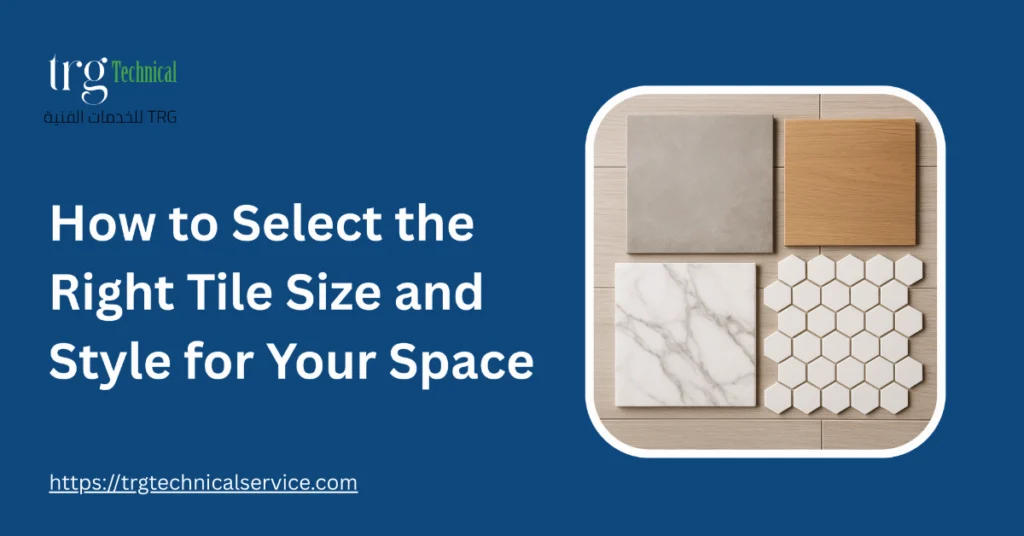How to Select the Right Tile Size and Style for Your Space

Tiles are more than just a functional element in a home—they are a powerful design tool that can elevate the style, enhance the mood, and even influence how large or small a space feels. With so many sizes, patterns, and finishes available, choosing the right tile for your space can feel overwhelming.
Whether you’re remodeling a kitchen, updating a bathroom, or designing a commercial space, understanding how to select the right tile size and style is essential for creating a cohesive and practical result.
This expert guide covers everything you need to know about choosing tiles based on space, lighting, layout, and design preferences.
1. Understand the Impact of Tile Size on Space Perception
The size of the tile you choose can dramatically affect how large or open a room appears.
Large Tiles (e.g., 24″x24″, 12″x24″, 18″x36″)
- Best for: Open areas like living rooms, hallways, and large bathrooms
- Effect: Fewer grout lines create a more seamless, expansive look
- Tip: Use large-format tiles in light shades to make small rooms feel bigger
Medium Tiles (e.g., 12″x12″, 8″x16″)
- Best for: Bathrooms, small kitchens, or entryways
- Effect: A balance between pattern and practicality
- Tip: Use a diagonal layout to visually widen narrow spaces
Small Tiles (e.g., mosaics, subway tiles, penny rounds)
- Best for: Backsplashes, shower walls, accent areas
- Effect: Adds intricate detail and texture
- Tip: Avoid too many small tiles in cramped areas they can overwhelm the space
2. Match Tile Style to Room Function
Every room has a different purpose, and the tile you choose should support both aesthetics and function.
Kitchen
- Recommended style: Glossy ceramic or porcelain for backsplashes; matte porcelain for floors
- Tip: Choose tiles that are easy to clean and resistant to moisture and grease
Bathroom
- Recommended style: Anti-slip textured tiles for floors; glazed tiles for walls and showers
- Tip: Use large tiles to reduce grout maintenance in high-moisture areas
Living Areas
- Recommended style: Wood-look porcelain tiles or natural stone
- Tip: Opt for warm tones and larger sizes to create a cozy, cohesive floor design
Outdoor Areas
- Recommended style: Textured or matte-finish tiles with high slip resistance
- Tip: Always check for frost and water resistance for exterior tiles
3. Coordinate with the Room’s Dimensions and Layout
Tile layout plays a critical role in enhancing your room’s visual appeal. For example:
- Horizontal tile placement can widen a room
- Vertical placement can make ceilings look taller
- Diagonal or herringbone layouts add movement and interest to square rooms
Avoid using very large tiles in tight, angular rooms, as excessive cutting can lead to waste and awkward seams.
4. Consider Color, Finish, and Grout
Tile style isn’t just about size—it includes color, finish, and grout decisions too.
Tile Color
- Light-colored tiles reflect light and open up spaces
- Dark-colored tiles add drama and coziness to large rooms
- Neutral shades provide timeless elegance and flexibility in styling
Tile Finish
- Glossy tiles are ideal for walls and backsplashes—they reflect light and are easy to clean
- Matte tiles offer a softer, natural look—better for floors, as they provide slip resistance
- Textured tiles add depth and character but may be harder to clean
Grout Choice
Grout isn’t just functional—it influences the overall appearance:
- Matching grout creates a seamless look
- Contrasting grout highlights individual tiles and patterns
- Epoxy grout is stain-resistant and ideal for high-traffic or wet areas
5. Factor in Maintenance and Durability
A tile’s appearance is important, but its ability to stand up to daily wear and tear matters just as much.
- Porcelain tiles are highly durable and water-resistant—ideal for floors and heavy-use areas
- Ceramic tiles are easy to cut and work with—suitable for low-traffic walls and backsplashes
- Natural stone tiles like marble and slate are elegant but require sealing and more maintenance
Ask your tile supplier for PEI (Porcelain Enamel Institute) ratings, which indicate tile hardness. Higher PEI ratings mean better durability for foot traffic.
6. Don’t Forget Scale and Balance in Design
If you’re using multiple tile types (e.g., floor and wall tiles), make sure they balance well. Avoid pairing very large floor tiles with tiny wall mosaics unless intentionally used as an accent.
A unified color palette and consistent grout width also help create harmony across different tile sizes and styles.
Read also: 5 Common Tile Installation Mistakes to Avoid
7. Consult a Professional for Large Projects
Choosing tile may seem simple, but for large or complex projects, consulting a designer or tile professional can help:
- Maximize layout efficiency
- Avoid over-ordering or under-ordering
- Recommend tiles based on your specific lighting, humidity, and usage conditions
Conclusion
Selecting the right tile size and style involves more than just picking what looks good in the showroom. It requires careful consideration of your space’s layout, purpose, lighting, and future maintenance needs.
By following these expert guidelines, you can confidently choose tiles that enhance the functionality, beauty, and value of your space.
Need help choosing or installing tiles in the UAE? Trust the specialists at TRG Technical Services.
From consultation to installation, we offer complete tile solutions for residential and commercial projects—delivered with precision and professionalism.


